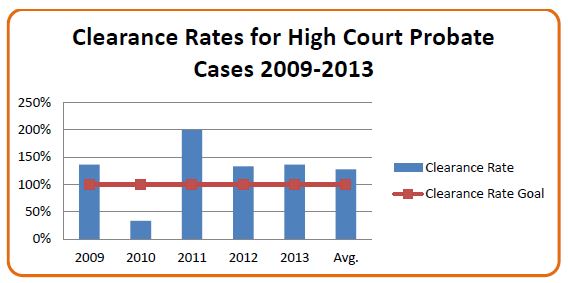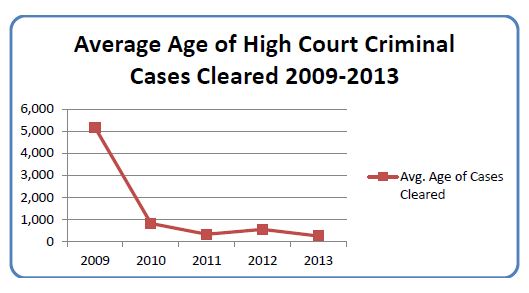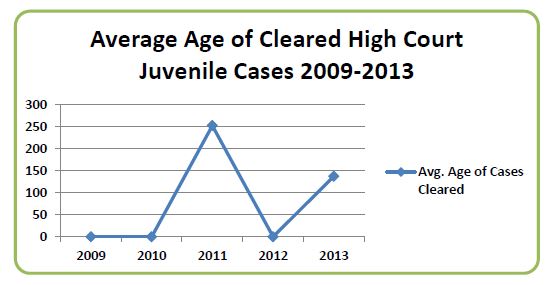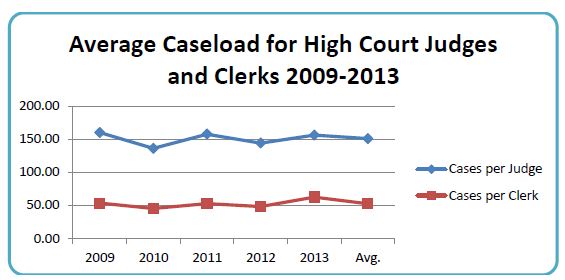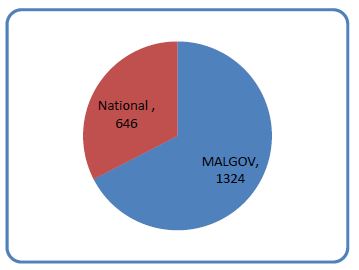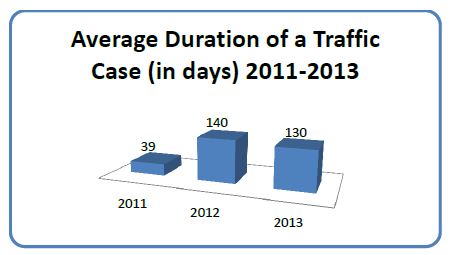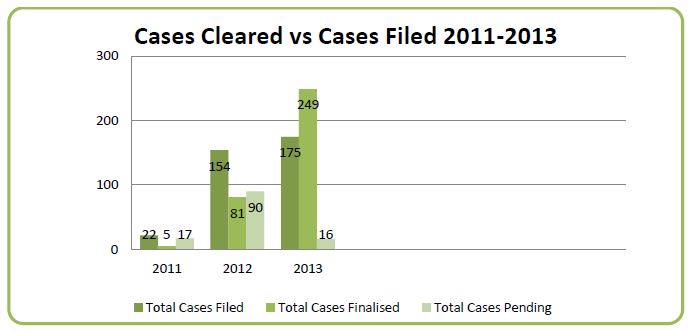You are here: PacLII
>> Databases
>> Marshall Islands
Judicial Annual Reports >> 2013 Annual
Report
2013
Annual Report
THE
JUDICIARY OF THE
REPUBLIC
OF THE MARSHALL
ISLAND

2013
REPORT
Download PDF version [1.6MB]
Table
of Contents
Message
from the Chief Justice
Our Values
Mission Statement
Vision
I.
INTRODUCTION
II.
SIGNIFICANT EVENTS OR ACCOMPLISHMENTS
A.
Ground Floor Court Room
B.
Renovation of TRC Chambers
C.
2014-2018 Strategic Plan
D.
15 Cook Islands Court Performance Indicators
III.
THE COURTS AND THEIR WORK: EFFICIENCY, QUALITY, AND
ACCESSIBILITY
A.
Supreme Court
B.
High Court
1.
Civil Cases (other than Probate Cases)
2.
Probate Cases
3.
Criminal Cases
4.
Juvenile Cases
5.
Caseloads for Judges and Clerks
6.
Selected Decisions
C.
Traditional Rights Court
D.
District Court
1.
Traffic Cases (Majuro)
2.
Criminal Cases (Majuro)
3.
Juvenile Cases (Majuro)
4.
Small Claims Cases (Majuro)
6.
Ebeye
E.
Community Courts
F.
Travel to the Outer Islands and Ebeye
G. Other Services: Births, Deaths,
Marriages, Notarizations, and Record Checks
1.
Majuro
2.
Ebeye
H.
Court Staff
I.
Professional Development and Regional Conferences
J.
Court Rules and Relevant Statutes
IV.
THE JUDICIAL SERVICE COMMISSION: JUDICIAL APPOINTMENTS
V.
ACCOUNTABILITY: CODES OF CONDUCT AND COMPLAINTS
VI.
FACILITIES, TECHNOLOGY, AND THE LIBRARY
A.
Facilities
B.
Technology
C.
The Library
VII.
SALARIES AND COMPENSATION
VIII.
THE ANNUAL BUDGET AND AUDIT REPORT
Appendix 1: Organizational Chart
Appendix 2: Judiciary Personnel
Appendix 3: Financial Statement
Message
from the Chief Justice
HIGH
COURT
of the Republic of the Marshall
Islands
Post
Office Box B
Majuro, MH 96960
Tele.: 692-625-3201
Fax: 692-625-3323
Iokwe,
I am pleased to present the 2013
Annual Report of the Judiciary of the Republic of the Marshall Islands. This report reflects the
dedication and hard
work of the judges and staff that serve the Judiciary, the Government,
and the people
of the Marshall Islands. It
is a
pleasure and a privilege to work with them.
On behalf of the Judiciary, I wish to
express our sincere appreciation to the President, the Minister of
Justice, and
the other members of the Cabinet for their support in 2013. Also, I
wish to
express our profound thanks to the Nitijela and the House of Iroij for
their
continuing support of our budgetary and legislative requests. We are committed
to working with the
Cabinet, the Nitijela, and the House of Iroij in the years to come to
maintain
a judiciary that is fair, efficient, and effective, assuring justice
for all
and the rule of law. Our
shared goals
mandate that we work together in a spirit of respect and cooperation.
Submitted with the 2013 Annual Report
are
our Values, Mission Statement, and Vision.
For more information about the Judiciary, please contact
me or the Chief
Clerk of the Courts at the above address.
Sincerely
yours,
Carl
B. Ingram
Chief Justice, High Court
Date: August 18, 2014
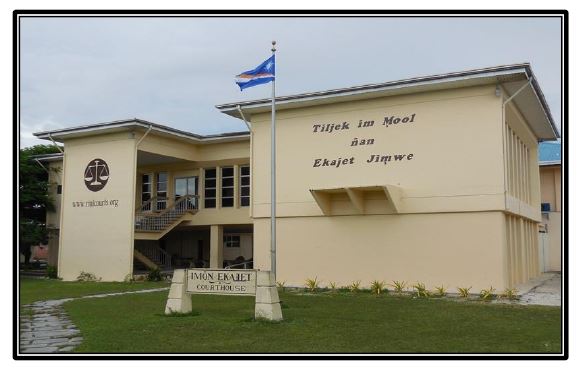
Our Values:
Tomak,
Jenok, im Aurok Ko Ad:
The Marshall Islands Judiciary holds
the
following values and desires to operate in a manner that is, and will
be
perceived as:
Jikin
Ekajet ko an Marshall Islands rej
debij im jerbal wot iumin tomak im aurok kein kab konan eo non air
jerbal ilo
wawein ko renaj koman bwe armej ren kalimjeklok ra eo an Jikin Ekajet
bwe ej
juon eo ej einwot in:
- accessible
- accountable
- competent
- consistent
- efficient
- fair and impartial
- independent
- respectful
- service-oriented, and
- valuing custom and
tradition, as well as
innovation.
|
- ebellok non aoleb
armej
- etiljek, ekkeke, im
maron uwak non jerbal
ko an
- ekakemooj im emmon an
komane jerbal eo an
- ej jokkin wot juon an
komane jerbal eo an
- ebolemen im tiljek
ilo an kakke aikuij ko
- ej jerbal jimwe ilo
ejelok kalijeklok im
jeb
- ejenolok im jutaklok
ian make
- ewor an kautiej armej
- etiljek, jela nae,
jela kunaan, im jela
karejar iben armej: im
- ej kaurok im kautiej
manit im men ko
bwinnid im ad jolet, ekoba lomnak im wawein jerbal ko rekaal.
|
These values form the basis for the
Judiciary's Mission Statement and Vision.
Tomak im aurok kein rej ejaake bedbed eo
non kottobar im ettonak kein ilal.
Mission Statement:
Kottobar Eo:
The mission of the courts of the Marshall
Islands, the Judiciary, is to fairly and efficiently resolve disputes properly
brought before them, discharging their judicial duties and responsibilities in
accordance with the Constitution, laws, and customs of this unique island
nation, for the benefit of those who use the courts' services.
Kottobar eo an Jikin Ekajet ko an Marshall
Islands ej non jerbal jimwe ilo ejelok kalijeklok im jeb ilo aoleb abnono ko
rej itok imair, im non komane jerbal in ekajet im edro ko air ekkar non
Jemen-Ei eo, kakien ko, im manit ko an ailon kein ad im jej jenolok kaki jen
lal ko jet ikijien manit im men ko bwinnid im ad jolet, non emmanlok eo an ro
rej bok jiban jen jikin ekajet eo.
Vision:
Ettonak Eo:
The Marshall Islands Judiciary will be an
excellent small-island judiciary, deserving of public trust and confidence.
- We will be fair and impartial.
- We will treat court users and colleagues
with dignity, courtesy, and respect, and we will require the same in return.
- We will provide affordable and accessible
services to court users.
- We will seek to resolve matters
efficiently, while maintaining quality, consistency, and certainty.
- We will be independent yet accountable,
deciding matters based upon the facts before us and a conscientious
understanding of the law and custom.
- We will administer the courts in accordance
with internationally recognized standards for leadership, management, and
accountability.
- We will seek and employ innovative
practices and procedures to better serve court users, to identify users' needs,
and to develop court personnel.
- We will maintain adequate and safe
courthouses and a supportive work environment.
We understand that these are ambitious
goals. However, recent history indicates
that they are within our grasp.
Ra eo an jikin ekajet eo an Marshall
Islands enaj juon raan jikin ekajet non ailin jidrik kein ad, eo im ebed liki
im tomak eo an armij ro ie.
- Kem naj jerbal jimwe ilo ejelok am
kalijeklok.
- Kem naj kile, kautej, im karejar ippen ro
rej kojerbal im bukot jiban jen jikin ekajet eo, ekoba dri-jerbal ro mottam, im
kemij kotmene bwe kom naj ukot tok ilo ejja wawein kein wot.
- Kem naj komman bwe en drik wonen, bidodo,
im ejelok aban non ro rej kojerbal im bok jiban jen jikin ekajet eo.
- Kem naj bukot kojkan bwe en mokaj, emman,
im jejjet wawein am bukot mejlan ailwaro im aikuj ko.
- Kem naj komman jemlok non abnono ko, ilo an
ejelok kibel jen ijoko jabrewot, bedbed wot ion menin kamol ko rej walok, im
jen am melele kin kien im manit.
- Kem naj kommani jerbal im eddro ko an court
ekkar non jonak im wawein ko lal in ej kili im lori ikijen jerbal in tel,
lolorjake, im bok eddro.
- Kem naj bukot im kojerbal wawein im
rebeltan jerbal ko rekaal bwe en emman lok am kake aikuj ko an ro rej kojerbal
jikin ekajet eo, im bareinwot non am kolablok kabeel ibben dri-jerbal ro ilo
jikin ekajet eo.
- Kem naj lolorjake bwe jikin ekajet ko ren
ainemmon im bolemeir, im bwe jitbon jerbal in ippen dron eo en wonmanlok wot.
Kem melele ke kottobar kein rellap.
Ijowotke, ilo ad reiliklok non jerbal ko emoj am tobari, ewor am kejatdrikdrik
bwe renaj tobrak.
2013 REPORT
OF THE JUDICIARY OF THE
REPUBLIC OF THE MARSHALL ISLANDS
I.
INTRODUCTION
The Republic of the Marshall Islands
consists of two nearly parallel archipelagic island chains of 29 atolls and
five separate islands—1,225 islands in all—located about half way between
Hawaii and Australia. The land area
totals 70 square miles but is scattered over 750,000 square miles of the
Western Pacific. As of July 2013, the
estimated population of the Marshall Islands was 55,000. However, estimates vary greatly.
The Republic of the Marshall Islands is a
young nation. After more than three decades
of United States administration under the United Nations Trust Territory of the
Pacific Islands, the Marshall Islands, as part of a process toward
self-government, commenced constitutional government on May 1, 1979. Seven and half years later, on October 21,
1986, the Marshall Islands formally regained independence through an agreement
with the United States, the Compact of Free Association, and is self-governing
under its own constitution.
Under the Constitution, the Marshall
Islands has a Westminister-style government with a 33-member parliament called
the Nitijela. At least every four years,
after national elections, the Nitijela elects from its members a president, who
in turn selects eight to ten other Nitijela members for his or her
cabinet. The Constitution vests
legislative authority in the Nitijela, executive authority in the Cabinet, and
judicial authority in the judiciary.
Article VI, of the Constitution, provides
for a judiciary "independent of the legislative and executive powers." The RMI Judiciary comprises five levels of
courts, as well as a Judicial Service
Commission and court staff. The courts
include the Supreme Court, the High Court, the Traditional Rights Court, the
District Court, and the Community Courts.
The RMI Judiciary officially commenced operation on March 3, 1982,
assuming judicial functions in the Marshall Islands that had been discharged by
the Trust Territory High Court. An
organizational chart of the RMI Judiciary is attached as Appendix 1, and a
listing of RMI Judiciary personnel for calendar year 2013 is attached as
Appendix 2.

In the sections that follow, this report
summarizes the RMI Judiciary's operations and accomplishments in calendar year
2013, as well as its challenges, including the need for financial support. These sections include the following:
- Significant Events or Accomplishments;
- The Courts and Their Work: Efficiency,
Quality, and Accessibility;
- The Judicial Service Commission: Judicial
Appointments;
- Accountability: Codes of Conduct and Complaints;
- Facilities, Technology, and the Library;
- Salaries and Compensation; and
- The Annual Budget and Audit Report.
II.
SIGNIFICANT EVENTS OR ACCOMPLISHMENTS
The dedication and hard work of the judges
and staff that serve the RMI Judiciary made 2013 a successful year. The most
significant events or accomplishments include the following:
- Construction of a ground-floor courtroom
at the Majuro Courthouse,
- Renovation of the Traditional Rights Court's
chambers,
- Completion of a new strategic plan for the
RMI Judiciary for years 2014-2018, and
- Repeating a second year as first among the
14 Pacific Island Countries on the 15 Cook Island Court Performance
Indicators.
A.
Ground Floor Court Room
The Majuro Courthouse, more than 30 years
old, was not designed to house its current occupants: two High Court justices,
three TRC judges, two District Court judges, and their staff. The three TRC
judges were housed in a small office designed for one prosecutor, and the
District Court's court room was a small office designed for one public
defender. These cramped quarters were inadequate for the judges and the public.
Furthermore, the RMI Judiciary's two full-sized court rooms were on the second
floor and not readily accessible by the disabled and older court users who
cannot easily walk up stairs, an unacceptable situation for most land cases
before the Traditional Rights Court (TRC).
Consistent with Strategic Goal 5: To
provide for and maintain the RMI Judiciary's facilities and technology, the RMI
Judiciary contracted with Anil Construction to build a new ground-floor
courtroom which was officially dedicated and opened on June 11, 2013 for use
mainly by the District Court and TRC judges. The ground-floor courtroom is considered
the RMI Judiciary's most significant accomplishment in 2013 for the following
reasons: (i) the RMI Judiciary, after years of collecting fees and
careful/prudent management of its own special revenue fund, was finally able to
fund the project and (ii) the new ground floor courtroom accommodates the
special needs of the public.
B.
Renovation of TRC Chambers
Additionally, with its own funds and with
financial assistance from the Republic of China, Taiwan, the RMI Judiciary
contracted with Pacific International Inc. (PII) to remodel the vacant District
Courtroom and old TRC quarters to provide more and better office space for the
TRC and a ground floor conference room for all. Planters near the main road
parking area have also been built in support of the Majuro beautification and
cleanup initiative. Further, rust spots on the Majuro Courthouse were repaired
and the courthouse was re-painted by Bingo Construction on a different project
as part of the RMI Judiciary's continuing efforts to maintain its
buildings.
C.
2014-2018 Strategic Plan
Another major accomplishment is the new
strategic plan for the Republic of the Marshall Islands Judiciary for
2014-2018. The RMI Judiciary's new Tiljek Im Mol Nan Ekajet Jimwe, Committed to
Justice, Strategic Plan builds upon the RMI Judiciary's 2007 plan, retaining
strategic goals, strategies, and actions that remain relevant, deleting actions
that have been performed and need not be repeated, and adding new goals,
strategies, and actions to meet
continuing and new challenges. This
strategic plan will serve to guide judges and court staff as they perform their
jobs. It will assist in determining how best to use available resources and
will provide a way to measure the accomplishments of the courts as they strive
to fulfill their mission.
D.
15 Cook Islands Court Performance Indicators
The RMI Judiciary is a member of the
Pacific Judicial Development Program (PJDP), comprising 14 Pacific Island
countries. In 2011, the PJDP adopted the
15 Cook Islands Court Performance Indicators.
For the second year in a row, the RMI Judiciary is the best at meeting
the 15 indicators. In 2011, the RMI
Judiciary reported on 14 of the 15 indicators; and in 2013 the RMI Judiciary
reported on all 15. These results are indicative of the RMI Judiciary's
commitment to transparency and accountability.
III.
THE COURTS AND THEIR WORK: EFFICIENCY, QUALITY, AND ACCESSIBILITY
The goals of the RMI Judiciary include to
be efficient, to produce quality decisions, and to be accessible. The RMI Judiciary's efficiency can be
measured by annual clearance rates, age of cleared cases, and age of pending
cases. The quality of decisions can be
measured by appeals and cases overturned on appeal. Accessibility can be measured by the fee
structure, cases heard on circuit, free legal counsel, the availability of
forms, and the accessibility of courthouses.
To this end, the 2013 Annual Report reviews for all five levels of the
RMI Judiciary—the Supreme Court, the High Court, the Traditional Rights Court,
the District Court, and the Community Courts—jurisdiction, staffing, and the
work of the courts, as well as continuing professional development for judges
and staff.
A.
Supreme Court
The Supreme Court, the court of last
resort, is a superior court of record having appellate jurisdiction with final
authority to adjudicate all cases and controversies properly brought before
it. An appeal lies to the Supreme
Court
(i) as of right from a final decision of
the High Court in the exercise of its original jurisdiction;
(ii) as of right from a final decision of
the High Court in the exercise of its appellate jurisdiction, but only if the case
involves a substantial question of law as to the interpretation or effect of
the Constitution; and
(iii) at the discretion of the Supreme
Court from any final decision of any court.
Also, the High Court may remove to the
Supreme Court questions arising as to the interpretation or effect of the
Constitution.
The Supreme Court consists of three
justices: a chief justice and two associate justices. To date, all Supreme Court judges have been
law-trained attorneys and most have been experienced judges. The current chief
justice, Daniel N. Cadra, is a United States citizen appointed to a second
10-year term effective September 2013.
Generally, associate justices have been pro tem judges from other
jurisdictions—for example, the United States Ninth Circuit Court of Appeals,
the United States Federal District Court in Hawaii, the Republic of Palau, the
Commonwealth of the Northern Mariana Islands, and Canada. In 2013, the pro tem associate justices were
two United States Federal Court judges from the Federal District Court in
Hawaii: District Court Judge Michael Seabright and Magistrate Judge Barry
Kurren. The Chief Clerk of the Courts,
Ingrid K. Kabua, serves as the clerk of the Supreme Court.
The Supreme Court's 2013 case and workload
are summarized as follows.
At the beginning of 2013, there were six
matters pending before the Supreme Court, and in 2013, another six matters were
filed, for a total of 12. The Supreme
Court cleared four matters in 2013: a 2006 land matter and three
writs/petitions filed by the same parties, who had earlier been declared
vexatious litigants. The Supreme Court affirmed the High Court judgment in the
land matter and denied all three writs/petitions. By the end of 2013, eight cases remained.
The Supreme Court's goal is to maintain an
annual clearance rate of 100%. As the
table below shows, the Supreme Court has done this in four of the past five
years. In 2013, with six cases filed and
four cases cleared, the annual clearance rate was only 66.67 % (4/6). However, the five-year average clearance rate
is over 100% at 335%.

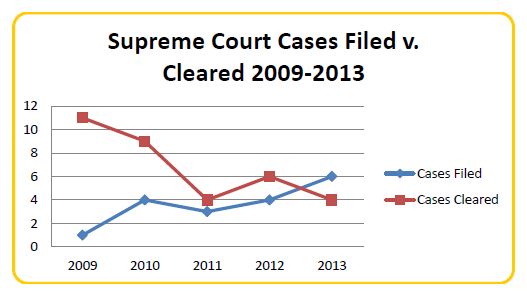
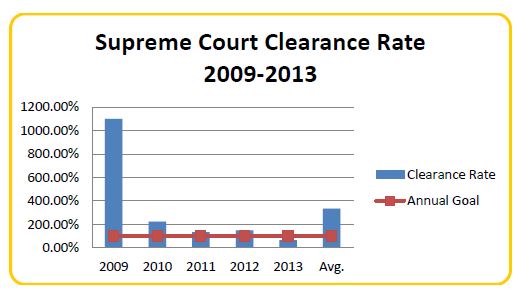
The average duration of the four cases
cleared in 2013 was 652.75 days.
However, if one excludes the old land matter from 2006, the average
duration for the remaining three cases was only 59 days. The five-year trend for the average age of
cleared Supreme Court cases is set out below in the table and chart. Because the Supreme Court's caseload only
includes a few cases, the five-year trend moves up and down and is not
meaningful.

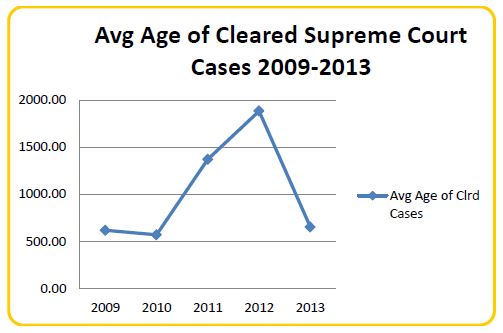
In none of the cases pending in 2013 did
the parties seek a fee waiver or legal aid.
The filing fee for appeals is $50.00.
The Supreme Court's decisions can be found
on the RMI Judiciary's website, http://rmicourts.org/,
under the heading Court Decisions and Digests.
Aside from the Supreme Court's regular
docket, in 2013, Supreme Court Chief Justice Cadra, together with High Court
Chief Justice Carl B. Ingram, admitted two attorneys to the practice of law in
the Republic: a Marshallese employed by the Office of the Attorney-General and
a non-citizen in private practice based in Guam.
B.
High Court
The High Court is the highest court at the trial
level. The High Court is a superior
court of record having general jurisdiction over controversies of law and fact
in the Marshall Islands. The High Court
has original jurisdiction over all cases properly filed with it, appellate
jurisdiction over cases originally filed in subordinate courts, and, unless
otherwise provided by law, jurisdiction to review the legality of any final
decision of a government agency.
The High Court currently consists of a
chief justice and one associate justice: in 2013, Chief Justice Carl B. Ingram
and Associate Justice James H. Plasman.
Both are law-trained attorneys, as have been all prior High Court
judges, and both attend at least one professional development seminar each
year. Chief Justice Ingram was appointed
to a second ten-year term commencing in October 2013. Associate Justice Plasman was re-appointed to
a second 4-year term commencing in January 2012. Both are United States expatriates with more
than 25-years' experience in the Marshall Islands.
During the 30 years the RMI Judiciary has
been in operation, one Marshallese attorney has served on the High Court
bench. He served for over six years
attaining the position of chief justice.
Although highly respected, he left to become a member of the parliament,
the Nitijela, which continues to attract many of the best Marshallese
attorneys.
In addition to the two justices, the Chief
Clerk of the Courts and four assistant clerks serve the High Court. The High Court's 2013 statistics for civil
cases, probate cases, criminal cases, juvenile cases, and caseloads are set
forth below.
1.
Civil Cases (other than Probate Cases)
The High Court's 2013 statistics for civil
cases (other than probate cases) cover the following:
- the number and nature of cases filed in
2013;
- the annual clearance rates for the past
five years;
- the average age of cleared cases for the
past five years;
- the average age of pending cases for the
past five years;
- the percentage of cases appealed and the
percentage of appealed cases overturned on appeal; and
- accessibility in terms of fee waiver,
cases heard on circuit, legal aid, and forms.
a. Number and Nature of Cases Filed in 2013
In 2013, plaintiffs and petitioners filed
281 new civil cases (other than probate cases) in the High Court: 258 in Majuro
and 23 in Ebeye.
The 258 civil cases filed in Majuro in 2013
breakdown as follows:
more than half, 193, involved domestic
matters (including 67 customary adoptions, 41 guardianships, 30 legal
adoptions, 0 domestic violence cases, 13 divorces, 8 child custody and support
cases, and 34 name-change cases);
- 7 citizenship cases;
- 25 collection cases;
- 9 land rights or land lease cases;
- 8 contract cases; and
- 16 other cases.1
Of the 258 civil cases filed in Majuro in
2013, 209 were cleared in 2013, leaving 49 pending at the end of the year. The four largest categories of pending cases
were as follows: 9 collection cases; 7 citizenship cases; 6 land or lease
cases; and 5 child custody and support cases.
Of the 23 civil cases filed in Ebeye in
2013, 7 were customary adoption cases, 4 guardianship cases, 11 name-change
cases, and 1 divorce case. In 2013, 17
of the 23 cases were cleared, leaving 6 pending at the end of the year. Of the 6 pending Ebeye civil cases pending
from 2013, 2 were customary adoption cases, 3 were name change cases, and 1 was
a guardianship.
The High Court's efficiency can be measured
in terms of annual clearance rates, the age of cleared cases, and the age of
pending cases.
b.
Annual Clearance Rates: 144.84% in 2013
In 2013, the High Court clearance rate for
civil cases was 144.84%: 407 cases were cleared and 281 were filed. The High
Court's goal is to maintain an annual clearance rate for civil cases of 100%,
or better, for each year. As the table
and chart below show, the High Court has done this over the past five years.

c. Average Age of Cleared Cases: 663 days
in 2013
In addition to annual clearance rates, the
efficiency of a case management system can be measured in the age of cleared
cases. The table and chart below show
that over the past five years the average age, the average age of the middle
75%, and the median age of cleared cases all have come down. This is due to the Court's backlog reduction
policy.

d.
Age of Pending Cases: 1,525 days in 2013
To get the clearest picture of the health
of one's case management system, courts also can look at the number and the age
of pending cases. That is, although the
number of pending cases may be going down, the age of pending cases may be
going up. This can result if a court is
towards the end of a successful backlog reduction project and the only cases
left are the ones that are very hard to move.
As the table and chart below show, that is what happened to the High
Court in 2013.
The number of cases pending dropped from
626 to 224. However, in 2013, the
average age of the pending cases went up.
e.
Appeals
In addition to measuring efficiency, it is
important to review the quality of judgments.
The quality of judgments can be measured in two ways: the percentage of
cases appealed and the percentage of appealed cases overturned on appeal.
In 2013, the number and percentage of High
Court civil cases appealed remained very low.
There were two appeals and four petitions to the Supreme Court. That is, 6 appeals or petitions versus 281
cases filed in the High Court, or 2.18%.
If one just considers appeals, the number is lower: 2 out of 281, or
0.71%.
Furthermore, in 2013, no 2013 High Court
cases or decisions were overturned on appeal.
The Supreme Court denied three of the four 2013 petitions. At the end of the year one petition and the
two appeals remained pending. Also in
2013, the Supreme Court affirmed the High Court's decision in a 2006
appeal. In 2013, no High Court civil
cases from 2013, or from previous years, were overturned on appeal. The percentage of cases overturned on appeal
was 0%.

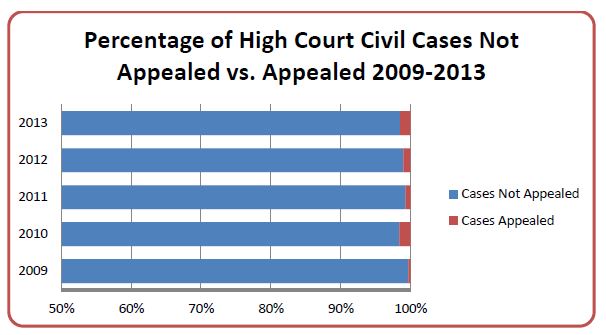
f.
Affordability and Accessibility: Fee Waiver; Cases Heard on Circuit;
Legal Aid; and Forms
It is not enough that courts be efficient
and that the quality of judgment be high.
The courts must be affordable and accessible. Affordability and accessibility to justice
may be measured in terms of the availability of fee waivers, the number of
cases heard on circuit, the availability of free legal service, and the
availability of forms.
(i) Fee Waiver
Although, by rule and statute, fee waivers
are available upon a showing of need, in 2013 no one requested a fee waiver in
a High Court civil case. The filing fee
for most types of High Court cases is $25.00.
The fee for domestic violence case has been repealed. Fees for admiralty cases, non-resident
corporate cases, international adoptions, and citizenship cases are
substantially higher.
(ii) Cases Heard on Circuit
Of the 281 civil cases filed in 2013, 23
cases (8%) were Ebeye circuit cases. Of
the 405 civil cases cleared in 2013, 83 cases (20.49%) were Ebeye circuit
cases.
(iii) Free Legal Services
In 2013, the use of free legal services
remained high. In 202 of the 281 civil
cases filed in 2013 (72%), at least one of the parties was represented by the
Micronesian Legal Services Corporation or the Office of the Public Defender,
both of which provide legal assistance for free. Also in 2013, 4 petitioners were assigned
free court-appointed attorneys for potential land cases. For FY 2013, the Nitijela appropriated
$24,700 to the RMI Judiciary to pay court-appointed attorneys to represent
those who cannot afford an attorney and for conflict reasons cannot use the
Micronesian Legal Services Corporation or the Office of the Public Defender.
(iv) Forms
The RMI Judiciary has long used forms in
small claims cases, name-change petitions, and guardianship cases. In 2013, the RMI Judiciary put forms on its
website for confirmation of customary adoptions, name-change petitions, fee and
cost waiver, domestic-violence temporary protection orders, guardianship
petitions, and small claims cases.
2.
Probate Cases
Set forth below are the High Court's 2013
case statistics for probate cases. These
statistics cover the following:
- the number of probate cases filed in 2013;
- the annual clearance rates for the past
five years;
- the average age of cleared cases for the
past five years;
- the percentage of cases appealed and the
percentage of appealed cases overturned on appeal; and
- accessibility in terms of fee waiver,
cases heard on circuit, and legal aid.
a.
Number of Cases
Eleven probate cases were filed in 2013, up
two from the nine filed in 2012: 10 in Majuro and one in Ebeye.
b.
Clearance Rates: 136% in 2013
In 2013, the High Court cleared 15 probate
cases: ten of the eleven 2013 probate cases; two 2012 cases; one 2010 case; one
2008 case and one 1994 case, for a 2013 clearance rate of 136% (15/11). The High Court's goal for probate cases is to
maintain an annual clearance rate of 100%, or better, for each year. As the table and chart below shows, the High
Court has achieved its goal for four of the past five years.
At the end of 2013, six probate cases were
pending. Three of those were cleared by
July 2014, and the remaining three are awaiting action by counsel.
c.
Average Age of Cleared Cases: 738.86 days in 2013
The average age of the 15 probate cases
cleared in 2013 was 738.86 days. If one
does not count the five old or abandoned cases, the average duration of the ten
of eleven 2013 probate cases cleared in 2013 was only 42.93 days. Unless an objection is filed, most probate
cases should be cleared within 7 to 9 weeks of filing, 49 to 63 days. Below is the five-year trend for the average
age of cleared probate cases. The
average ages are relatively high, as the Court has been trying to get counsel
to resolve old and abandoned cases.

d.
Appeals
In
2013, no probate cases were appealed, nor were any cases from previous years
overturned on appeal. Accordingly, the percentage of probate cases appealed was
0%, and the percentage of appealed probate cases overturned on appeal was 0%. This
is consistent with results from the past four years.
e.
Affordability and Accessibility: Fee Waiver; Cases Heard on Circuit; and Legal
Aid
As
noted above, affordability and accessibility to justice can be seen in the
availability of fee waivers, the number of cases heard on circuit, and the
availability of free legal service.
As
with other civil cases, fee waiver is available in probate cases. However, in
2013 (as in recent years) no one requested a fee waiver in a probate case. The
filing fee for probate cases is $25, $100 for estates over $7,000.
Of
the eleven probate cases filed in 2013, one was an Ebeye circuit case (9.09%). Of
the 15 probate cases cleared in 2013 (from all years), three were Ebeye circuit
cases (20%). In 14 of the 15 probate cases cleared in 2013 (93.33%), either the
petitioner or an objector was represented by the Micronesian Legal Services
Corporation (MLSC) or the Office of the Public Defender (PD). These figures are
typical of most years.
3.
Criminal Cases
Set
forth below are the High Court’s 2013 case statistics for criminal cases. These
statistics cover the following:
- the
number and nature of criminal cases filed in 2013
- the
annual clearance rates for past five years;
- the
average age of cleared cases for the past five years;
- the
percentage of cases appealed and the percentage of appealed cases overturned on
appeal; and
- accessibility
(fee waiver, cases heard on circuit, and legal aid).
a.
Number and Nature of Cases
In
2013, the Office of the Attorney-General filed only 16 criminal cases in the
High Court: 11 in Majuro and five in Ebeye.
The
11 criminal cases filed in Majuro in 2013 breakdown as follows: one negligent
homicide; two murder; two aggravated assaults or assaults with a deadly weapon;
two sexual assaults; one burglary and conspiracy; one forgery; one smuggling of
goods in the Republic; and one child abuse and neglect case. The five felony
cases filed in Ebeye in 2013 breakdown as follows: one sexual assault; one
burglary and theft; and the other three involved assaultive behavior. There
were no criminal appeals from the District Court.
A
total of three women were defendants in two criminal cases filed in Majuro in
2013. In none of the five Ebeye cases was the defendant a woman.
Women
were victims in two of the 11 criminal cases filed in Majuro in 2013. One case
involved domestic violence, the continuous sexual assault of a minor female
family member, but was not charged as such. No protective order was requested. Of
the five Ebeye cases, a woman was the victim in one sexual assault case. That
case involved domestic violence. Counseling to victims of domestic violence and
sexual violence is available through NGOs, including Youth-to-Youth in Health
and Women United Together Marshall Islands.
b.
Clearance Rates: 113% in 2013
In
2013, the High Court cleared 18 criminal cases from all years, two more than
the number of cases filed in 2013, resulting in a 2013 clearance rate of 113%
(18/16). This clearance rate is a result of clearing a number of 2013 cases as
well as cases filed in previous years. Although the 2013 clearance rate has
dropped significantly compared to last year’s annual clearance rate of 238%, it
is still in line with the High Court’s goal to maintain an annual clearance
rate for criminal cases of 100%, or better, per year.

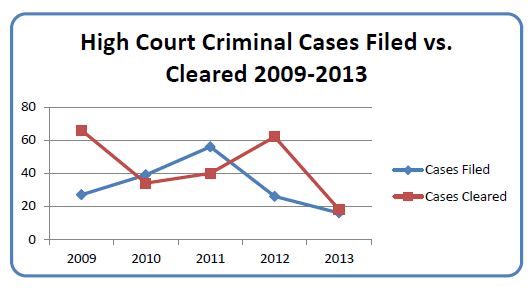
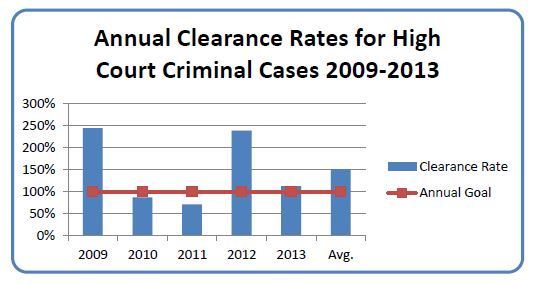
By
the end of 2013, approximately 29 criminal cases remained pending. The High
Court has encouraged the Attorney-General and defense counsel to resolve
criminal cases without delay, particularly those that are more than a year old,
about 20. Seven of the 20 old cases have proven difficult to resolve because
the defendants have fled the Republic for the United States or have fled Majuro
or Ebeye for the outer islands.
c.
Average Age of Cleared Case: 250 days in 2013
The
average age of High Court criminal cases cleared in 2013 was 250.00 days. The
number of High Court criminal cases cleared in the past five years (2009-2013)
and the average duration of cleared cases are as shown below. The high number
of cleared cases and average age of cleared cases in 2009 is the result of a
major backlog reduction effort.

d.
Appeals
As an
indication of the quality of High Court criminal decisions, in 2013 no High
Court criminal cases were appealed, nor were any cases from previous years
overturned on appeal. Accordingly, the percentage of criminal cases appealed
and the percentage of appealed criminal cases overturned on appeal was 0%. This
is consistent with results from the past four years.
e.
Affordability and Accessibility: Fee Waiver; Cases Heard on Circuit; and Legal
Aid
To
ensure accessibility to justice, the RMI Judiciary does not impose fees on
criminal defendants at the trial level. On appeal, a defendant may apply for a
fee waiver for the filing fee. Also, to ensure accessibility, criminal cases
are heard on circuit and criminal defendants have access to free legal counsel.
Of
the 16 criminal cases filed in 2013, 5 cases (31%) were Ebeye circuit cases. Of
the 18 criminal cases cleared in 2013, five cases (28%) were Ebeye circuit
cases.
In
2013, as in other years, most criminal defendants were represented by the
Office of the Public Defender, the Micronesian Legal Services Corporation, or a
court-appointed attorney paid for by legal aid funds (two). In 2013, the
defendants received legal assistance at no cost in 14 of 16 cases (87.5%). In
the remaining two cases, private attorneys were retained. This percentage is
typical of most years.
4. Juvenile Cases
Set forth below are the High Court's 2013
case statistics for juvenile cases.
These statistics cover the following:
- the number and nature of juvenile cases
filed in 2013;
- the annual clearance rates for past five
years;
- the average age of cleared cases for the
past five years;
- the percentage of cases appealed and the
percentage of appealed cases overturned on appeal; and
- accessibility (fee waiver, cases heard on
circuit, and legal aid).
a.
Number and Nature of Cases
In 2013, the Office of the Attorney-General
filed only 4 juvenile cases in the High Court: 2 in Majuro and 2 in Ebeye. Since 2006, when the Republic filed six
juvenile cases, the Republic has filed only one or two juvenile cases per year
in the High Court. Most juvenile cases
(underage drinking) are heard by the District Court, not the High Court.
The two 2013 juvenile cases filed in Majuro
involved sexual assaults by 15 year-old males.
Younger children were the victims: one female and one male. The two 2013 juvenile cases filed in Ebeye
involved burglary and theft by males.
b.
Clearance Rates: 25% in 2013
In 2013, the High Court cleared only one of
four juvenile cases filed in 2013, resulting in a 2013 clearance rate of only
25% (1/4). The High Court's goal is to
maintain an annual clearance rate for juvenile cases of 100% or to dispose of
juvenile cases within six months of filing.
The one juvenile case cleared in 2013 was cleared within six months, but
not the others.
The annual clearance rates for juvenile
cases for 2009 to 2013 are shown below.
By the end of 2013, approximately 8
juvenile cases remained pending, seven in Ebeye and one in Majuro. Four of the Ebeye cases were very old
abandoned and inactive cases. In 2014,
the High Court cleared all 8 pending juvenile cases. As of end of July 2014, there were no pending
juvenile cases. The High Court has
encouraged the Attorney-General and defense counsel to resolve juvenile cases
without delay.
c.
Average Age of Cleared Cases: 137 days in 2013
As only one juvenile case was cleared in
2013, the average age of cleared juvenile cases is the same as the age of the
one case, 137. For juvenile cases filed
in the past five years (2009-2013), the average duration of cleared cases in
days are set forth below. Because the
High Court sees so few juvenile cases the figures do not reveal a meaningful
trend. What is important is that as of
the date of this report, there are no pending juvenile cases before the High Court.

d.
Appeals
As an indication of the quality of High
Court juvenile decisions, in 2013 no High Court juvenile cases were appealed,
nor were any cases from previous years overturned on appeal. Accordingly, the percentage of juvenile cases
appealed and the percentage of appealed juvenile cases overturned on appeal was
0%.
e.
Affordability and Accessibility: Fee Waiver; Cases Heard on Circuit; and
Legal Aid
To ensure accessibility to justice, the RMI
Judiciary does not impose fees on juvenile defendants at the trial level. On appeal, a defendant may apply for a fee
waiver. Also, to ensure accessibility,
juvenile cases are heard on circuit and juvenile defendants have access to free
legal counsel.
Of the four juvenile cases filed in 2013,
two cases (50.00%) were Ebeye circuit cases.
The one juvenile case cleared in 2013 was not an Ebeye circuit case.
Finally, and most important, accessibility
to justice is assured by access to free legal representation. In 2013, as in other years, most juvenile
defendants were represented by the Office of the Public Defender, the
Micronesian Legal Services Corporation, or a court-appointed attorney paid for
by legal aid funds. In all four cases
filed in 2013, the defendants received legal assistance at no cost (100%). This
percentage is typical of most years.
5.
Caseloads for Judges and Clerks
The total number of all High Court cases
filed in 2013 was 312. For the two High
Court Justices this equates to an average caseload of 156 new cases for 2013. These figures are consistent with recent
years, although the figures fluctuate:
- for 2013, 156 cases per justice;
- for 2012, 144 cases per justice;
- for 2011, 157.5 cases per justice;
- for 2010, 136 cases per justice; and
- for 2009, 160 cases per justice.
Generally, cases are assigned between the
two judges on an alternating basis.
For the five clerks that regularly process
High Court cases, their 2013 caseload included 52 new cases per clerk. As with the justices, the clerks' caseloads
fluctuate from year-to-year within a limited range:
- for 2013, 62.4 cases per clerk;
- for 2012, 48 cases per clerk;
- for 2011, 52.50 cases per clerk;
- for 2010, 45.33 cases per clerk; and
- for 2009, 53.33 cases per clerk.
There is some specialization among the
clerks, but all clerks handle most functions.

6.
Selected Decisions
Selected High Court decisions can be found
on the RMI Judiciary's website, http://rmicourts.org/,
under the heading Court Decisions and Digests.
The selected cases are the noteworthy ones; ones that the Judiciary
believes should be published for the benefit to the public and
practitioners. The High Court will not
publish a case unless it satisfies one or more of the following standards: (1)
the opinion lays down a new rule of law, or alters, modifies an existing rule,
or applies an established rule to a novel fact situation; (2) the opinion
involves a legal issue of continuing public interest; (3) the opinion directs
attention to the shortcomings of existing common law or inadequacies in
statutes; (4) the opinion resolves an apparent conflict of authority. Most High Court decisions are routine in
nature and generally are of interest only to the parties. However, the public can get copies of these
decisions upon request to the Clerk of the Courts.
C.
Traditional Rights Court
Supporting the High Court at the trial
level is the Traditional Rights Court ("TRC"). The TRC is a special-jurisdiction court of
record consisting of three or more judges appointed for terms of four to ten
years and selected to include a fair representation of all classes of land
rights: Iroijlaplap (high chief); where applicable, Iroijedrik (lower chief);
Alap (head of commoner/worker clan); and Dri Jerbal (commoner/worker).
In June 2010, the Cabinet appointed Chief
Judge Walter K. Elbon (alap member) and Associate Judge Grace L. Leban (dri
jerbal member) for terms of 10 years. In
April 2013, the Cabinet appointed Nixon David (iroij member) for a 4-year
term. All TRC judges are lay judges who
receive specialized training.
One of the three TRC judges, Judge Leban,
is a woman, the first woman to be appointed as a full-time TRC judge. The RMI Judiciary is committed to increasing
the number of female judges. However,
only two of the RMI Judiciary's approximately 33 judges are women: one
Traditional Rights Court judge and one Community Court judge.
The jurisdiction of the TRC is limited to
questions relating to titles to land rights or other legal interests depending
wholly or partly on customary law and traditional practices. The jurisdiction of the TRC may be invoked as
of right upon application by a party to a pending High Court proceeding,
provided the High Court judge certifies that a substantial question has arisen
within the jurisdiction of the TRC.
Customary law questions certified by the
High Court are decided by the TRC panel and reported back to the High
Court. Upon request by the TRC's
presiding judge, a party, or the referring High Court judge, the Chief Justice
of the High Court may appoint a High Court or District Court judge to sit with
the TRC to make procedural and evidentiary rulings. In such joint-hearing cases, the High Court
or District Court judge does not participate with the TRC in deliberations on
its opinion, but may in the presence of the parties or their counsel answer
questions of law or procedure posed by the TRC.
The TRC's jurisdiction also includes rendering an opinion on whether
compensation for the taking of land rights in eminent domain proceedings is
just.
The Constitution states that the High Court
is to give decisions of the TRC substantial weight, but TRC decisions are not
binding unless the High Court concludes that justice so requires. The Supreme Court has held the High Court is
to review and adopt the TRC's findings unless the findings are clearly
erroneous or contrary to law.
In 2013, the TRC held two trials. One decision was issued in 2013, and the
other decision was issued in early 2014.
As of the date of this report, the TRC has issued a second opinion in
2014 and is working on one more.
Approximately 21 cases (2014 cases included) are pending before the TRC
and are under active review. The TRC has
set two of the 21 pending cases for trial before the end of the year.
The TRC's decisions can be found on the RMI
Judiciary's website, http://rmicourts.org/,
under the heading Court Decisions and Digests.
D.
District Court
In addition to the TRC, District Court is
below the High Court at the trial level.
The District Court is a limited-jurisdiction court of record. It consists of a presiding judge and two
associate judges appointed for 10-year terms.
At the end of 2013, the three incumbent judges were Presiding Judge
Milton Zackios, Associate Judge Jimata M. Kabua, and Associate Judge A. Tarry
Paul (Ebeye). Their 10-year terms expire
in 2015, 2016, and 2019, respectively.
The current District Court judges are lay
judges who receive specialized training.
The District Court has original jurisdiction concurrent with the High
Court
(i) in civil cases where the amount claimed
or the value of the property involved does not exceed $10,000 (excluding
matters within the exclusive jurisdiction of the High Court by Constitution or
statute, such as land title cases and admiralty and maritime matters) and
(ii) in criminal cases involving offenses
for which the maximum penalty does not exceed a fine of $4,000 or imprisonment
for a term of less than three years, or both.
The District Court also has appellate
jurisdiction to review any decision of a Community Court.
The District Court's 2013 case statistics
and case workload are set forth below.
1.
Traffic Cases (Majuro)
The District Court's 2013 statistics for
Majuro traffic cases cover the following:
- the number and nature of cases filed in
2013;
- the annual clearance rates for the most
recent three years;
- the average duration of cleared cases for
the most recent three years;
- the percentage of cases appealed and the
percentage of appealed cases overturned on appeal; and
- accessibility in terms of fee waiver,
cases heard outside of Majuro (the Capital), legal aid, and forms.
a.
Number and Nature of Cases Filed in 2013
In 2013, the National Police and Majuro
Atoll Local Government Police prosecutors filed in the District Court a total
of 1,970 traffic cases in Majuro. A
total of 179 cases involved DUI/Drunken Driving.
Of the 1,970 traffic cases filed in Majuro
in 2013, 1,468 were cleared in 2013, leaving 502 pending at the end of the
year. A large number of cases remained
pending at the end of the year because police had difficulty locating
defendants who relocated to the United States or to the outer islands of the
Republic or who gave false addresses.

b.
Clearance Rates: 99.34% in 2013
The District Court's efficiency can be
measured by case clearance rates. The
District Court's 2013 annual clearance rate for traffic cases was 99.34%
(1,957/1,970). During 2013, the District
Court, counsel, and parties closed 1,468 2013 cases and 489 cases from previous
years. And as noted above, the
government filed 1,970 new cases in 2013.
The District Court's goal is to maintain an annual clearance rate for
traffic cases of 100% or better, for each year.
As a result of its efforts to process cases without undue delay, the
District Court was able to gradually increase its clearance rate as shown below.

As the above chart also shows, from cases
filed in 2011 through 2013, 335 cases remained pending. The District Court each month dismisses
without prejudice abandoned cases that have been pending six months or
more.
c. Average Duration of Traffic Cases
Cleared in 2013
The average duration of District Court
traffic cases cleared in 2013 was 130 days.
Excluding cases from earlier years cleared in 2013, the average duration
of 2013 traffic cases cleared in 2013 is only 46 days.
For Majuro District Court traffic cases
filed in the past three years (2011-2013), the average durations of cleared
cases in days were as follows:
d.
Appeals
In addition to measuring efficiency, it is
important to review the quality of judgments.
The quality of judgments can be measured in two ways: the percentage of
cases appealed and the percentage of appealed cases overturned on appeal.
In 2013, none of the 1,957 District Court
traffic cases cleared in 2013 were appealed to the High Court. Similarly, in 2011 and 2012, no traffic cases
were appealed.
Furthermore, in 2013, there were no
District Court traffic cases or decisions overturned from any year on
appeal.
e.
Affordability and Accessibility: Fee Waiver; Cases Heard Outside of Majuro;
Legal Aid; and Forms
It is not enough that courts be efficient
and that the quality of judgment be high.
The courts must be affordable and accessible. Affordability and accessibility to justice
may be measured in terms of the availability of fee waivers, the number of
cases heard outside of the capital Majuro, the availability of free legal
service, and the availability of forms.
(i) Fee Waiver
As there is no filing fee for traffic
cases, fee waiver is not applicable.
(ii) Cases Heard on Ebeye
A third District Court judge is stationed
in Ebeye to handle District Court matters including traffic cases filed
there.
(iii) Free Legal Services
At the District Court level, most traffic
offenders are self-represented. Only in
more serious cases, such as those involving DUI, do they seek legal assistance
and representation by the Micronesian Legal Services Corporation or the Office
of the Public Defender, which both provide free legal assistance. Of the 1,970 traffic cases filed in 2013, only
72 defendants (3.65%) were represented by the Office of the Public
Defender.
(iv) Forms
Consent judgment forms are available at the
Clerk's Office for traffic offenders who wish to plead guilty and pay a
fine. Those who use the form do not have
to appear in court.
2.
Criminal Cases (Majuro)
The District Court's 2013 statistics for
Majuro criminal cases cover the following:
- the number and nature of cases filed in
2013;
- the annual clearance rates for the most
recent three years;
- the average duration of cleared cases in
the most recent three years;
- the percentage of cases appealed and the
percentage of appealed cases overturned on appeal; and
- accessibility in terms of fee waiver,
cases heard outside of Majuro, legal aid, and forms.
a.
Number and Nature of Cases Filed in 2013
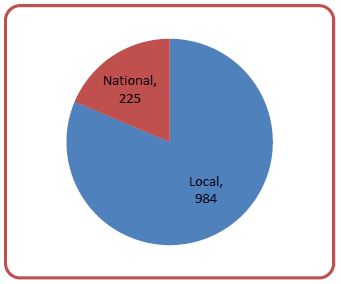
In 2013, the National Police and Majuro
Atoll Local Government Police prosecutors filed in the District Court a total
of 1,209 criminal cases in Majuro.
Of the 1,209 criminal cases, 861 were
cleared in 2013, leaving 348 pending at the end of the year. A large number of cases remained pending at
the end of the year because police had difficulty locating defendants who
relocated to the United States or to the outer islands of the Republic or who
gave false addresses.
b.
Clearance Rates: 109.92 in 2013
The District Court's 2013 annual clearance
rate for criminal cases was 109.92 % (1,329/1,209). During 2013, the District Court, counsel,
and parties closed 861cases and 468 cases from previous years. As noted below, the government filed 1,209
new cases in 2013. The District Court's
goal is to maintain an annual clearance rate for criminal cases of 100% or
better, for each year.
c. Average Duration of Cleared Criminal
Cases: 174 days in 2013
In addition to annual clearance rates, the
efficiency of a case management system can be measured by the age of cleared
cases. The average age of District Court
criminal cases cleared in 2013 was 174 days.
d.
Appeals
In addition to measuring efficiency, it is
important to review the quality of judgments.
The quality of judgments can be measured in two ways: the percentage of
cases appealed and the percentage of appealed cases overturned on appeal.
In 2013, none of the 1,329 District Court
criminal cases cleared in 2013 were appealed to the High Court. Also in 2013, there were no District Court
criminal cases or decisions from any years overturned. This is the same for previous years.
e.
Affordability and Accessibility: Fee Waiver; Cases Heard Outside of
Majuro; Legal Aid; and Forms
It is not enough that courts be efficient
and that the quality of judgment be high.
The courts must be affordable and accessible. Affordability and accessibility to justice
may be measured in terms of the availability of fee waivers, the number of
cases heard outside of the capital Majuro, the availability of free legal
service, and the availability of forms.
(i) Fee Waiver
As there is no filing fee for criminal
cases, free waiver is not applicable.
(ii) Cases Heard on Ebeye
A third District Court judge is stationed
in Ebeye to handle District Court matters including criminal cases filed
there.
(iii) Free Legal Services
At the District Court level, most
defendants are self-represented. Only in
more serious cases, such as those involving selling alcohol to minors and
assault and battery, do defendants seek legal assistance and representation by
the Micronesian Legal Services Corporation or the Office of the Public
Defender, which both provide free legal assistance. Of the 1,209 criminal cases filed in 2013,
only 20 defendants (1.65%) were represented by the Office of the Public
Defender.
(iv) Forms
Consent judgment forms are available at the
Clerk's Office for defendants who wish to plead guilty and pay a fine. Those who use the form do not have to appear
in court.
3.
Juvenile Cases (Majuro)
The District Court's 2013 statistics for
juvenile cases cover the following:
- the number and nature of cases filed in
2013;
- the annual clearance rates for the most
recent three years;
- the average duration of cleared cases;
- the percentage of cases appealed and the
percentage of cases overturned on appeal; and
- accessibility in terms of fee waiver,
cases heard outside of Majuro, legal aid, and forms.
a.
Number and Nature of Cases Filed in 2013
In 2013, the National Police and Majuro
Atoll Local Government Police prosecutors filed in the District Court a total
of 175 juvenile cases in Majuro. A total
of 123 cases involved curfew violations, 37 involved underage drinking and
alcohol related charges, and 15 cases involved traffic related charges and
littering.
Of the 175 juvenile cases filed in Majuro
in 2013, 158 were cleared in 2013, leaving 17 pending at the end of the year.
In 2014, all 17 pending cases were cleared.
b.
Clearance Rates: 142.29% in 2013
The District Court's efficiency can be
measured by case clearance rates. The
District Court's 2013 annual clearance rate for juvenile cases was 142.29%
(249/175). During 2013, the District
Court, counsel, and parties closed 91 cases from 2012. And as noted below, 175 new cases were filed
in 2013. The District Court's goal is to
maintain an annual clearance rate for juvenile cases of 100% or better, for
each year. As a result of its efforts to
process cases without undue delay, the District Court was able to gradually
increase its clearance rate as shown below.

Also the above chart shows, from cases
filed in 2011 through 2013, 16 cases remained pending. The District Court each month dismisses
without prejudice abandoned cases that have been pending six months or
more.
c. Average Duration of Cleared Juvenile
Cases: 213.31 in 2013
In addition to annual clearance rates, the
efficiency of a case management system can be measured by the age of cleared
cases. The average age of District Court
juvenile cases cleared in 2013 was 213.31 days.
District Court juvenile cases cleared in the past three years
(2011-2013), the average durations of cleared cases in days are as shown above.
d.
Appeals
In addition to measuring efficiency, it is
important to review the quality of judgments.
The quality of judgments can be measured in two ways: the percentage of
cases appealed and the percentage of appealed cases overturned on appeal.
In 2013, none of the 249 District Court
juvenile cases cleared in 2013 were appealed to the High Court. Similarly, in 2011 and 2012, no juvenile
cases were appealed.
Furthermore, in 2013, there were no
District Court juvenile cases or decisions from any years overturned on
appeal.
e.
Affordability and Accessibility: Fee Waiver; Cases Heard Outside of
Majuro; Legal Aid; and Forms
It is not enough that courts be efficient
and that the quality of judgment be high.
The courts must be affordable and accessible. Affordability and accessibility to justice may
be measured in terms of the availability of fee waivers, the number of cases
heard outside of the capital Majuro, the availability of free legal service,
and the availability of forms.
(i) Fee Waiver
As there is no filing fee for juvenile
cases, fee waiver is not applicable.
(ii) Cases Heard on Ebeye
A third District Court judge is stationed
in Ebeye to handle District Court matters including juvenile cases filed
there.
(iii) Free Legal Services
At the District Court level, most juvenile
offenders are self-represented. Only in
more serious cases do they seek legal assistance and representation by the
Micronesian Legal Services Corporation or the Office of the Public Defender,
which both provide free legal assistance.
Of the 175 juvenile cases filed in 2013, no juvenile offenders (0%) were
represented by the Office of the Public Defender. The Office of the Public Defender represented
5 juvenile offenders in 2011 and one in 2012.
(iv) Forms
Consent judgment forms are available at the
Clerk's Office for juvenile offenders who wish to plead guilty and pay a
fine. Those who use the form do not have
to appear in court.
4.
Small Claims Cases (Majuro)
The District Court's 2013 statistics for
Majuro small claims cases cover the following:
- the number and nature of cases filed in
2013;
- the annual clearance rates for the most
recent three years;
- the average duration of cleared cases;
- the percentage of cases appealed and the
percentage of cases overturned on appeal; and
- accessibility in terms of fee waiver,
cases heard outside of Majuro, legal aid, and forms.
a.
Number of Cases Filed in 2013
In 2013, a total of 392 small claims cases
were filed in Majuro.
Of the 392 small claims cases filed in
Majuro in 2013, 247 were cleared in 2013, leaving 145 pending at the end of the
year. Cases that remained pending at the
end of the year involved defendants who reside in the outer islands.
b.
Clearance Rates: 71.43% in 2013
The District Court's efficiency can be
measured by case clearance rates. The
District Court's 2013 annual clearance rate for small claims cases was
71.43% (280/392). During 2013, the District Court, counsel, and
parties closed 280 cases from previous years.
And as noted below, 392 new cases were filed in 2013. The District Court's goal is to maintain an
annual clearance rate for small claims cases of 100% or better, for each year

Also the above chart shows, from cases
filed in 2011 through 2013, 190 cases remained pending.
c. Average Duration of Cleared Small Claims
Cases: 49.34 days in 2013
In addition to annual clearance rates, the
efficiency of a case management system can be measured by the in the age of
cleared cases.
The average duration of District Court
small claims cases cleared in 2013 was 49.34 days, a significant drop compared
to previous years.
For Majuro District Court small claims
cases cleared in the past three years (2011-2013), the average duration of
cleared cases in days were as follows:
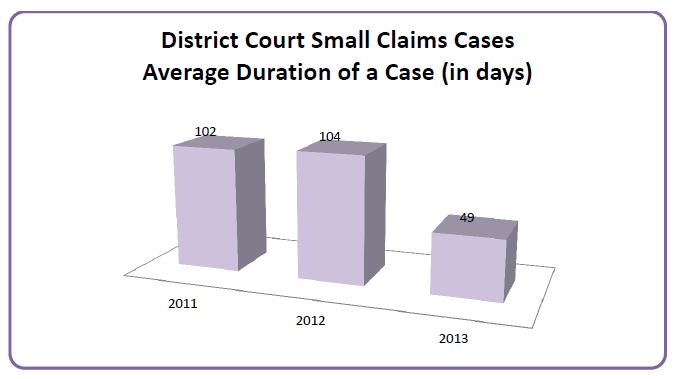
d.
Appeals
In addition to measuring efficiency, it is
important to review the quality of judgments.
The quality of judgments can be measured in two ways: the percentage of
cases appealed and the percentage of appealed cases overturned on appeal.
In 2013, none of the 392 District Court
small claims cases cleared in 2013 were appealed to the High Court. Similarly, in 2011 and 2012, no small claims
cases were appealed.
Furthermore, in 2013, there was no District
Court small claims cases or decisions from any years overturned on appeal.
e.
Affordability and Accessibility: Fee Waiver; Cases Heard Outside of
Majuro; Legal Aid; and Forms
It is not enough that courts be efficient
and that the quality of judgment be high.
The courts must be affordable and accessible. Affordability and accessibility to justice
may be measured in terms of the availability of fee waivers, the number of
cases heard outside of the capital Majuro, the availability of free legal
service, and the availability of forms.
(i) Fee Waiver
Although, by rule and statute, fee waivers
are available upon a showing of need, plaintiffs did not request a fee waiver
in any of the 2013 District Court small claims cases. The filing fee for small claims cases remains
low at only $5.00 dollars.
(ii) Cases Heard on Ebeye
A third District Court judge is stationed
in Ebeye to handle District Court matters including small claims cases filed
there.
(iii) Free Legal Services
At the District Court level, most
plaintiffs and defendants in small claims cases are self-represented. Only in a few cases do defendants seek legal
assistance and representation by the Micronesian Legal Services Corporation or
the Office of the Public Defender, which both provide free legal
assistance. Of the 392 small claims cases
filed in 2013, only 7 defendants (1.8%) were represented by the Micronesian
Legal Services Corporation or the Public Defender. Others appeared pro se.
(iv)
Forms
Small claims forms are available on the
court's website (www.rmicourts.org) or at
the Clerk's Office.
In summary, a total of 3,746 cases were
filed in the Majuro District Court: 1,970 traffic cases; 1,209 criminal and
local government ordinance cases; 175 juvenile case; 392 small claims cases;
and no other civil cases.
5. Caseload for Judges and the Clerks.
The average number of new cases heard by
the two District Court judges in Majuro was 1,886.5 cases, and the average
number of new cases per court clerk (two from the RMI Judiciary and two from
Majuro Atoll Local Government) was 943.25.
In 2013, the average number of cases heard by the two Majuro judges was
1,610, and the average number of cases per court clerk was 1,073.
6.
Ebeye. In 2013 on Ebeye, 449
cases were filed in the District Court: 44 small claim cases (43 cleared and
one pending); 70 traffic cases (66 cleared and 4 pending); no juvenile cases;
41 criminal cases (35 cleared and six pending); and 294 local government
ordinance cases (290 cleared and four pending).
The average number of cases heard per
District Court judge in Ebeye was 449, and the average number of cases per court
clerk was the same.
No 2013 Ebeye District Court cases were
appealed or overturned on appeal.
In all Ebeye District Court small claims
cases, the parties were self-represented.
The PD represented the defendant in 53 of the 66 traffic cases that were
cleared (80.30%), in all of the 35 criminal cases that were cleared (100%), and
in three of the 290 ordinance cases cleared
(1.03%). In the remaining 287
ordinance cases, six were represented by private counsel and 281 defendants
paid the ticket without contesting the matter.
E.
Community Courts
On the smaller outer islands the RMI
Judiciary has Community Courts. A
Community Court is a limited-jurisdiction court of record for a local
government area, of which there are 24.
Each Community Court consists of a presiding judge and such number of
associate judges, if any, as the Judicial Service Commission may appoint. Appointments are made for 4-year terms. Community Court judges are lay judges with
limited training. A Community Court has
original jurisdiction concurrent with the High Court and the District Court
within its local government area
(i) in all civil cases where the amount
claimed or the value of the property involved does not exceed $200 (excluding
matters within the exclusive jurisdiction of the High Court by Constitution or
statute, such as land title cases and admiralty and maritime matters) and
(ii) in all criminal cases involving
offenses for which the maximum penalty does not exceed a fine of $400 or
imprisonment for a term not exceeding six months, or both.
At the end of 2013, there were 25 serving
Community Court judges and five vacancies.
Currently, there are three vacancies for which the Commission is
waiting recommendations from local government councils: Enewetak (1); Rongelap
(1); and unallocated (1).
Community court judges receive training
when they come to Majuro for summer church conferences and on other
occasions. The RMI Judiciary encourages
all Community Court judges who are in Majuro for other business to stop by the
courthouse and arrange for training opportunities with the District Court
judges. In 2012, the RMI Judiciary held
a one-week workshop for Community Court judges. The next workshop was held
August 11-15, 2014. The RMI Judiciary
intends to continue providing trainings for Community Court judges every two years.
F.
Travel to the Outer Islands and Ebeye
The RMI Judiciary continues to travel to
the outer islands on an as-needed basis.
The RMI Judiciary believes that if the
offices of the Attorney-General, the Public Defender, and the Micronesian Legal
Services Corporation were to station attorneys on Ebeye full time, there would
be enough work to justify stationing a third High Court judge in Ebeye. Currently, the High Court travels to Ebeye
once every quarter if cases are ready to proceed. The additional personnel cost for a third
High Court judge would be about $100,000.
The RMI Judiciary would seek a budget increase to cover this cost and
related expenses (for example, recruitment costs and the one-time cost of
constructing chambers for a High Court judge on Ebeye). A High Court judge on Ebeye could, when the
need arises, more easily hold trials on the northern atolls. Also, a third High Court judge is needed to
relieve the heavy administrative burden on the two existing High Court judges.
If, however, the Government cannot afford
to station attorneys full-time on Ebeye, the RMI Judiciary would request that
at the very least the Office of the Attorney-General and Office of the Public
Defender receive funding to employee trial assistants on Ebeye, as was the
practice until very recently. Defendants
brought before the District Court on criminal charges have a constitutional
right to legal counsel.
G. Other Services: Births, Deaths,
Marriages, Notarizations, and Record Checks.
In addition to deciding cases, the courts
help the people through confirming delayed registrations of births and death,
performing marriages, notarizing documents, issuing record checks. The courts offer these services on no or
little notice. However, couples usually
schedule marriages one to three days in advance. Marriages by non-citizens must first be
approved by the Ministry of Foreign Affairs.
1.
Majuro. In 2013 on Majuro, the
High Court and the District Court processed 294 delayed registrations of birth,
12 delayed registrations of death, and performed 72 marriages.
The clerks notarized 552 documents. Upon request, clerks will go the hospital or
homes to notarize documents for those who cannot make it to the
courthouses. Also, the clerks issued 72
criminal record checks and 146 corporate litigation checks.
2.
Ebeye. In 2013 on Ebeye, the
District Court processed 30 delayed registrations of birth, 1 delayed
registration of death, and performed 12 marriages. The clerk also notarized 218 documents (1
sick visited and 6 visits to High Chief).
The five-year totals for birth, deaths,
marriages, and notarizations are as shown below.
H.
Court Staff
In 2013, the RMI Judiciary's staff included
the following: a chief clerk of the courts, six assistant clerks (one in
Ebeye), three bailiffs (seconded from the National Police), and one maintenance
worker. The chief clerk and three of the
six assistant clerks are women. A
listing of the judiciary personnel is attached as Appendix 2.
In addition to their administrative
responsibilities, the clerks also serve as interpreters from Marshallese to
English and English to Marshallese. The Office of the Attorney-General has a
Chinese translator on staff, provided by the Republic of China (Taiwan)
Embassy. Also, the clerks assist unrepresented
court users complete forms.
The Office of the Clerk of the Courts is
open 8:00 a.m. to noon and 1:00 p.m. to 5:00 p.m., Monday through Friday,
except holidays. In case of emergencies,
the courts will open on weekends and holidays.
The contact information for the Majuro and the Ebeye Courthouses is as
follows:
Majuro Courthouse
P.O. Box B
Majuro, MH 96960
Tel.: (011-692) 625-3201/3297
Fax: (011-692) 625-3323
The Majuro Courthouse is located in Uliga
Village, Majuro Atoll, across from the Uliga Dock.
Ebeye Courthouse
P.O. Box 5944
Ebeye, Kwajalein Atoll, MH 96970
Tel.: (011-692) 329-4032
Fax: (011-692) 329-3032
The Ebeye Courthouse is located behind the
Police Station on the Oceanside.
I.
Professional Development and Regional Conferences
"To manage the RMI Judiciary's
personnel in accordance with sound leadership and management practices" is
the fourth goal of the RMI Judiciary's 2014-2018 Strategic Plan. Consistent with this goal, Strategies 4.1,
4.2, and 4.3, and internationally recognized practice, in 2013 the RMI
Judiciary provided and facilitated professional development opportunities for
both judges and court staff. All
permanent justices and judges of the Supreme Court, the High Court, the
Traditional Rights Court, and the District Court attended such workshops and
conferences. Also, six of the seven
clerks attended professional development workshops. The participants found that the programs met
or exceeded their expectations, and addressed recognized training needs. Funding for such programs came from the RMI
Judiciary's annual operating budget, the Compact of Free Association,
Australia, and New Zealand. The RMI
Judiciary's 2013 professional development activities are set forth below.
In January 2013, High Court Associate
Justice James H. Plasman, District Court Presiding Judge Milton Zackios,
District Court Associate Judges Jimata Kabua and Tarry Paul attended a four-day
PJDP-sponsored Judicial Sentencing Process Training/Workshop in Yap State,
Federated States of Micronesia. Associate Justice Plasman was the chief
facilitator/presenter for the sessions devoted to judges. Among the topics covered were the
following: the purposes of sentencing,
sentencing tools, sentencing procedure, appellate issues in sentencing,
application of sentencing factors, writing the sentencing order, and the role
of custom in sentencing.
In late February, District Court Associate
Judge Ablos T. Paul attended the Pacific Judicial Development Program sponsored
Capacity Building Training of Trainers Workshop in Auckland, New Zealand. This
10-day intensive certification-level workshop continued the capacity building
approach to training-of-trainers developed by the PJDP. The training aimed to
equip participants to be confident and competent trainers, and to enable them
to build capacity within their own country and region.
In March 2013, Chief Justice Ingram
attended three conferences in New Zealand and Australia. First, Chief Justice
Ingram attended the 19th AIJA Oration in Judicial Administration held in
Auckland, New Zealand. The theme of the oration was "The Pursuit of
Excellence and Innovation in Courts and Tribunals." Most of the presenters
delivered paper on the International Framework for Court Excellence, a court
performance tool that had just been revised to address the concerns of smaller
jurisdictions. The IFCE, as revised, may provide the RMI Judiciary with a
suitable framework for improving its performance and services. Also at the
oration, Chief Justice Ingram presented a paper entitled "Successful
Leadership in Times of Crisis," outlining the elements of successful
leadership during emergencies. Immediately after the AIJI oration, Chief
Justice Ingram attended the Pacific Judicial Development Program's conferences
for National Coordinators and Chief Justices, also held in Auckland. The
purpose of these conferences was to review and adopt regional court improvement
projects for the 24-month period commencing in July 2013. The projects will be
funded by New Zealand and administered by the Federal Court of Australia. The
projects included the promotion of National Judicial Development Committees,
Time Standards, Annual Reports, Codes of Conduct, Juvenile Justice, and Access
to Justice. The RMI Judiciary has taken, and will continue to take, advantage
of the PJDP's projects. Finally, Chief Justice Ingram traveled to Sydney,
Australia, to attend the 6th World Conference on Family Law and Children's
Rights including a two-day visit to the Family Court of Australia to learn of
recent innovations in family law.
In mid-March 2013, TRC Associate Judge
Grace Leban attended the National Judicial College course "Fundamentals of
Evidence." At the course she was
introduced to the fundamental principles of evidence with a focus on using the
rules to decide evidentiary issues. The course was designed to benefit judges
without law degrees who are looking for a better understanding of evidence.
In late April 2013, District Court
Associate Judge Tarry Paul attended the National Judicial College course "Logic
and Opinion Writing (JS 621)."
After the course he was able to define basic terms and concepts in the
formal study of logic; describe the premises of inductive reasoning; explain
the anatomy of an opinion with the use of orientation paragraphs; issue
statements, findings of fact and conclusions of law or disposition; and state
the emphasis to be given to style, such as focus, sentence structure and
revision.
In late May 2013, TRC Chief Judge Walter
Elbon, District Court Presiding Judge Milton Zackios, and District Court
Associate Judge Jimata Kabua attended the National Judicial College course "Evidence
in a Courtroom Setting."
Participants reviewed the Federal Rules of Evidence (upon which the
Marshall Islands Rules of Evidence are based) and compared them with the rules
of evidence in their jurisdictions. This
was a highly interactive seminar in which judges from different jurisdictions
and backgrounds can openly and vigorously examined the rules of evidence in the
everyday courtroom setting. Participants
examined those evidentiary issues that cause the most difficulty for judges
including ethical issues, relevancy, lay and expert witnesses, impeachment,
privileges, best evidence and demonstrative evidence, authentication, hearsay
and its exceptions, electronic evidence and judicial notice.
In June 2013, High Court Associate Justice
James H. Plasman attended the Pacific Regional Consultation for Judges on Human
Rights and Contemporary Pacific Issues.
As part of panel discussion on domestic violence, Justice Plasman
delivered a paper on the judicial response to gender based violence in the
Marshall Islands. Other topics covered
during the consultation included
Challenges to Judicial Independence and the Rule of Law; Protecting
Constitutional Government in times of political crisis—Lessons from Solomon
Islands and Nauru; a workable balance between democratic principles and
traditional governance in Palau's state governments; Equality and Non-discrimination—
emerging principles and their application; The challenge of disability rights;
De-criminalization of anti-sodomy law in India—tackling the issues of
Constitutional Morality, Public Health and Individual Rights. Also part of the program was a visit to the
Brisbane Family Court and discussion of various family court issues.
In mid-July 2013, High Court Chief Justice
Carl B. Ingram attended the Judicial Governance Programme conducted by the
Subordinate Courts of Singapore, together with the Singapore Civil Service
College. The 5-day training program
provided participants with a systematic review of key reforms that have been
implemented in Singapore, and it highlighted the different approaches that have
been adopted, including developments in and challenges to judicial processes
and management. The program's main
themes were as follows: Fundamentals of Good Court Governance; Delivery of
Quality Justice; Strategy Development; Case Management Practices; Alternative
Dispute Resolution; International Framework for Court Excellence; and
Innovative Use of Technology.
In late August 2013, High Court Associate
Justice James H. Plasman attended the National Judicial College course "Best
Practices in Handling Cases with Self-Represented Litigants." Course participants learned how better to
recognize when an indigent self-represented party may be
entitled to court-appointed counsel; move a self-represented party civil docket
expeditiously; use settlement techniques in cases involving self-represented
litigants; recognize the limits on assisting self-represented parties; and
apply innovative methods and strategies to ensure that these litigants have
proper access to the justice system.
In late September 2013, Assistant Clerks of the Court Nikki Holly and
Tanya Lomae, who are responsible for the RMI Judiciary's finances, attended the
2013, 24th Annual Conference of the Association of Pacific Islands Public
Auditors ("APIPA") which was held in Saipan. The 2013 APIPA conference offers four tracks:
Audit, Audit Supervisor, Finance, and Advanced Finance. The two clerks attended the Finance track,
which included the following courses: Assessing Risk in Your Organization; How
to Clean Up Your Audit: Enhancing Internal Controls over Grants; An
Organization's Responsibility in Establishing Performance Measures; and Process
Improvement in Finance Operations: What Is the Process? And What Everyone
Should Know When Reviewing Government Contracts.
In October of 2013, Chief Clerk of the
Courts Ingrid Kabua and Assistant Clerks Travis Joe, Hainrick Moore, and
Stephen Clark, attended the PJDP Court Annual Reporting Workshop in Brisbane,
Australia. At the workshop, court
officers involved in the production of their court annual report were educated
on court reporting, the 15 PJDP Cook Island indicators, and in general, what it
takes to create a good annual report.
Tools, graph or chart creators providing different ways of displaying
data and information, and a report template were provided to all participants
to assist in the production of their court annual reports.
In October 2013, Chief Clerk of the Courts
and RMI Judiciary National Coordinator Ingrid K. Kabua attended the PJDP
sponsored 5th National Coordinator's Leadership Workshop in Brisbane,
Australia. The intention of the meeting was to provide an opportunity to
confirm and coordinate PJDP activities on a regional and bi-lateral basis; to
provide an overview of the progress of activities and toolkits; and to enable
interaction, exchange and building capacity to continue leading judicial
development nationally.
In late October 2013, Chief Justice Ingram
attended the Pacific Judicial Development Program's 5th Chief Justices'
Leadership Workshop held in Brisbane.
The workshop opened with a report from the PJDP Implementation Team on
the progress of the PJDP's programs and a report from the national coordinators
(of which Chief Clerk Ingrid Kabua was one) on the way forward. Thereafter, the
chief justices reviewed the various PJDP programs with the program consultants
and the suggestions from the national coordinators and approved a schedule for
delivery of the projects over the next year. The Marshall Islands will benefit
from projects on legal writing, time standards, and performance standards.
In late October 2013, High Court Chief Justice Carl Ingram attended
the 15th Conference of Chief Justices of Asia and the Pacific in Singapore from
October 28 to October 30 ("CJ's Conference") and the Asia Pacific
Judicial Reform Forum in Singapore from October 31 to November 1, 2013 ("APJRF
Conference"). Participants at the
CJ's Conference heard presentations and participated in discussions on the
following topics: integrity; independence; transparency; and promoting trade
and development. Participants at the
APJRF Conference heard presentations and participated in discussions under the
following topics: public and international confidence in the legal systems;
judicial rule in interpreting constitutions and laws; corruption in legal
systems; and judicial training and skills development.
J.
Court Rules and Relevant Statutes
To enhance access to justice, the RMI
Judiciary regularly reviews and amends or seeks amendment of its rules of
procedure and evidence. Over the past 10
years, the RMI Judiciary has proposed or adopted 20 sets of amendments.
In 2013, the RMI Judiciary has submitted to
Cabinet for its consideration 10 bills regarding the following:
- clarifying the distinction between parole
and probation officer;
- increasing fees for service of
process;
- increasing the salary of Community Court
judges;
- providing a "needs test" for the
Office of the Public Defender;
- de-criminalizing traffic offenses;
- regarding the terms of Traditional Rights
Court judges;
- regarding the terms of District Court
judges;
- regarding legal representation for the RMI
Judiciary and the use of local counsel as pro tem judges;
- increasing the term and jurisdiction of
Community Court judges; and
- amending the legal profession act to
provide for police prosecutors and other matters.
The first five bills were passed into law
in 2013. The RMI Judiciary is seeking to
get the second five adopted in 2014.
Also in 2013, the RMI Judiciary updated the
Rules of Civil Procedures to make them more readable for lay readers.
IV.
THE JUDICIAL SERVICE COMMISSION: JUDICIAL APPOINTMENTS
Along with the courts, the Constitution
provides for a Judicial Service Commission, which consists of the Chief Justice
of the High Court, as chair, the Attorney-General, and a private citizen
selected by the Cabinet. The private
member is Maria K. Fowler. The JSC
nominates to the Cabinet candidates for appointment to the Supreme Court, High
Court and TRC, and the Commission appoints judges to the District Court and the
Community Courts. In appointing
Community Court judges, the Commission takes into consideration the wishes of
the local communities as expressed through their local government
councils. The Commission also may make
recommendations to the Nitijela regarding the qualifications of judges. In the exercise of its functions and powers,
the Commission shall not receive any direction from the Cabinet or from any
other authority or person, but shall act independently. The Commission may make rules for regulating
its procedures and generally for the better performance of its functions.
In 2013, the Commission nominated to the
Cabinet Supreme Court Chief Justice Daniel N. Cadra for re-appointment, High
Court Chief Justice Carl B. Ingram for re-appointment, two Supreme Court pro
tem justices for re-appointment, and one pro tem High Court justice for
appointment. Also, the Commission
appointed or renewed the appointments of four Community Court judges.
V.
ACCOUNTABILITY: CODES OF CONDUCT AND COMPLAINTS
The third goal of the RMI Judiciary's
Strategic Plan includes "to be accountable." To enhance its transparency and
accountability, the RMI Judiciary has adopted internationally recognized
standards for judicial and attorney conduct.
These standards are available to the public as are the procedures for
lodging complaints against judges, attorneys, and court staff.
With respect to judicial conduct, the RMI
Judiciary has adopted the Marshall Islands Code of Judicial Conduct 2008
(revised February 16, 2012). The Code is
based upon the Bangalore Principles and the American Bar Association Code of
Judicial Conduct. A copy of the RMI
Judiciary's code can be found on its website, www.rmicourts.org/ under the heading "The
Marshall Islands and Its RMI Judiciary."
The provisions for lodging and processing complaints against judges
start on page 12 of the code. In 2013,
no complaints were lodged against judges.
In the past five years, only three
complaints have been lodged against judges.
Those three complaints, lodged by related self-represented parties
against a single judge, were dismissed as without merit. The proper remedy for parties who are
dissatisfied with a judge's decision is to appeal the judge's decision. Dissatisfaction with a judge's decision is
not grounds for filing a complaint against the judge. Over the past five years, the percentage of
complaints per case filed has been less than 1% for all courts and all judges.
With respect to attorney conduct, the RMI
Judiciary has adopted the American Bar Association Rules of Professional
Responsibility. Provisions for lodging
and processing complaints against attorneys can be found on the RMI Judiciary's
website under the heading "Rules of Admission and Practice." The Supreme Court and High Court have
appointed an attorney-committee to hear complaints. In 2013, no complaints were lodged against
attorneys, however, from 2012 there were six complaints pending review by the
attorney-committee. The Chief Justice of
the High Court has encouraged the committee to resolve the complaints as soon
as they can.
With respect to court staff, the RMI
Judiciary maintains a complaint box at the courthouses. In 2013, no complaints were lodged against
court staff. Nor have there been any
complaints lodged against court staff within the past five years.
VI.
FACILITIES, TECHNOLOGY, AND THE LIBRARY
"To administer the RMI Judiciary's
buildings and equipment in accordance with sound management practices" is
the fifth goal of the RMI Judiciary's Strategic Plan.
A.
Facilities
Over the past five years, the RMI
Judiciary, with the help of the Cabinet and the Nitijela, has renovated the
Majuro Courthouse and the Ebeye Courthouse to make them safe, secure, and
accessible. With funds collected from
fees, the RMI Judiciary contracted with Anil Construction to build a
ground-floor courtroom at Majuro Courthouse.
The project was completed in May 2013, providing easier access to court
services for users with disabilities.
Also in 2013, Pacific International Inc. completed renovation of the
chambers of the Traditional Rights Court and Bingo Construction Company
repainted the Majuro Courthouse. The RMI
Judiciary hopes to re-roof the Majuro Courthouse in 2014 and in the future acquire
solar panels for both the Majuro and Ebeye courthouses.
B.
Technology
The courthouses on Majuro and Ebeye are
equipped with computers, printers, faxes, and photocopiers and have Internet
access (@ 3.0 MPs in Majuro and 1.5 MPs in Ebeye). The courts permit the filing and service of
documents via fax and email attachment.
The computers in Majuro are linked together in a network, and the Majuro
Courthouse has two scanners with OSC software permitting the courts to scan
documents and send them almost anywhere in the world. Over the past three years, the RMI Judiciary
has replaced all of its older computers.
However, software updates remain a critical need and from time-to-time
computers crash and must be replaced.
With funds collected from fees, the RMI
Judiciary contracted with the National Telecommunication Authority to install a
fiber optic Internet connection at the Majuro Courthouse. The installation was completed in May 2013. With the fiber optic connection, the RMI
Judiciary will determine if it is feasible to use videoconferencing
equipment. Currently, the High Court
permits off-island counsel to attend status and scheduling conferences via
Skype. Occasionally, evidence in
uncontested matters is taken via Skype or telephone. The RMI Judiciary uses the Internet to
enhance access to justice.
C.
The Library
The RMI Judiciary has a small, but
functional, law library which includes hard copies of the following: United
States Supreme Court cases through 2006; American Law Reports First, Second,
Third, Fourth, part of Fifth, and Federal; LaFave on Criminal Law, Criminal
Procedure, and Search and Seizure; Wharton on Criminal Law and Criminal
Procedure; American Jurisprudence 2nd; Wright and Miller on Federal Practice
and Procedure; Moore's Federal Practice; and others. Also, the RMI Judiciary has up to date online
access to United States case law and secondary sources through a WestLaw
Internet subscription.
VII.
SALARIES AND COMPENSATION
At current pay levels, the RMI Judiciary is
having difficulty retaining and attracting qualified personnel at all
levels. In 2009, the Nitijela hired away
one of the RMI Judiciary's senior clerks.
This problem is particularly acute for assistant clerks of the courts at
the lower pay levels, i.e., 8, 9, and 10.
Finding qualified applicants who can translate Marshallese and English
and who can perform other necessary tasks is proving increasingly difficult. Although many may be interested in working
with the courts, when they find out that they have to translate in public their
interest fades. Without qualified
translators, the RMI Judiciary cannot function.
To stay competitive, the RMI Judiciary needs to increase pay levels,
particularly for assistant clerks of the courts.
Also, the salaries of High Court justices
($70,000 per annum for the chief justice and $60,000 per annum for the
associate justice) lag behind salaries for comparable law-trained judges in
Palau, American Samoa, the Northern Mariana Islands, and Guam ($90,000 to
$125,000 for presiding judges or chief justices). In 2008, the RMI Judiciary asked that the
salaries of the chief justice and the associate justice of the High Court be
increased to $80,000 and $70,000, respectively.
These salaries are justified by the quality and quantity of work done,
although they would still lag behind salaries paid in the above-named
jurisdictions. The RMI Judiciary, while
recognizing current fiscal constraints, seeks the salary adjustment to account
for inflation. Unfortunately, in 2012
the Nitijela, eliminated the COLA for judges.
The RMI Judiciary respectfully asks the Cabinet and the Nitijela to
appoint a Nitijela committee to examine judicial compensation.
VIII.
THE ANNUAL BUDGET AND AUDIT REPORT
"To manage the RMI Judiciary's
financial resources in accordance with sound financial practices" is the
sixth goal of the RMI Judiciary's Strategic Plan. This is evidenced not only by the work of the
courts, but also by the RMI Judiciary's management of the funds made available
to it.
For FY 2013, the Nitijela appropriated
$1,038,507 for the RMI Judiciary: $615,904 for salaries and wages and $422,603
for all others. Less audit expenses of $8,308 paid out by the Ministry of
Finance, a total of $414,295 was paid to the RMI Judiciary for its operational
funds.
Of the $1,038,507 Nitijela appropriation
for FY13, the RMI Judiciary expended only $958,483. The unexpended balance is attributable to
Marshallese salaries and benefit, particularly the Associate Judge vacancy
(Iroij Representative) of the Traditional Rights Court that was filled later in
2013 and the Community Court judge positions that were vacant at one time or
the other during the fiscal year. This
amount shall be significantly reduced for FY 2014, as more and more Community
Court judge positions are being filled.
However, the money the RMI Judiciary did spend, a Deloitte and Touche
audit confirms that the RMI Judiciary spent the money well.
Earlier this year, the RMI Judiciary
received its first audit carried out by Deloitte and Touche. Deloitte reported a clean audit with no
unresolved findings for FY 2013.
Attached as Appendix 3 is the statement of revenues, expenditures, and
changes in the RMI Judiciary Fund balance, Year ended September 30, 2013.
The RMI Judiciary by act has its own
special revenue fund ("RMI Judiciary Fund"). Court fines and fees (excluding national
criminal fines) collected by the Office of the Clerk of the Courts are
deposited into this fund. As highlighted
in the Significant Events or Accomplishments section of this report (page 6),
funding for the new ground floor courtroom was made possible through the RMI
Judiciary Fund. Due to the project, the
RMI Judiciary's total expenditures for FY 2013 were significantly higher than
the total revenues received leaving a negative net change in the fund balance
of $133,971, as shown on the statement.
However, with monies from the RMI Judiciary's special revenue fund, the
fund balance at the end of the year was $163,599. Fines and fees collected by the Office of the
Clerk of Courts and deposited into the RMI Judiciary Fund in FY 2013 totaled
$47,427. The fund balance at the end of
the year, $163,599, and all monies collected to date will be used to fund a new
courthouse roof as the current roof has begun to deteriorate. However, we may need additional funds from
the Nitijela to complete the project and to install energy efficient solar
panels on the new roof.
Appendix 1
ORGANIZATIONAL CHART
FOR THE
MARSHALL ISLANDS JUDICIARY
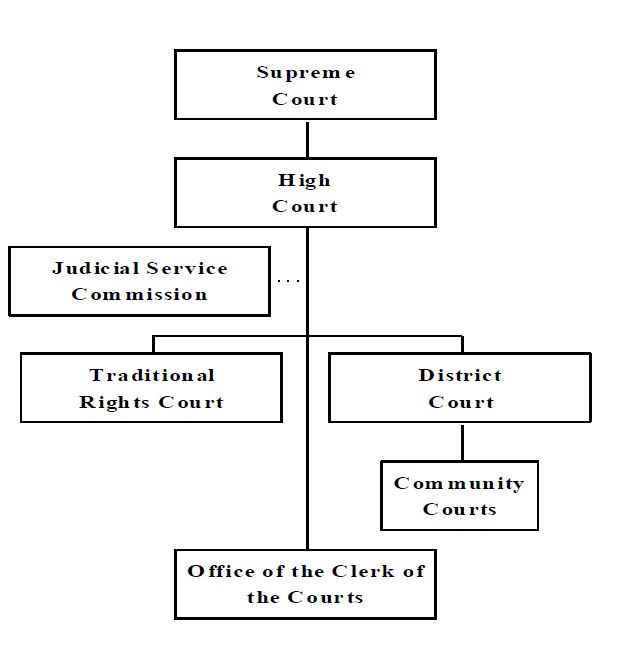
Appendix 2
JUDICIARY PERSONNEL
Justices and Judges
Supreme Court Chief Justice Daniel N. Cadra
(9/21/13-9/20/23)
High Court Chief Justice Carl B. Ingram
(10/5/13-10/4/23)
High Court Associate Justice James H.
Plasman (1/6/12-1/5/14)
Traditional Rights Court Chief Judge Walter
K. Elbon (7/04/10-7/03/20)
Traditional Rights Court Associate Justice
Nixon David (4/7/13-4/6/17)
Traditional Rights Court Associate Justice
Grace L. Leban (7/04/10-7/03/20)
Presiding District Court Judge Milton
Zackios (4/4/05-4/3/15)
Associate District Court Judge Jimata M.
Kabua (10/30/06-10/29/16)
Associate District Court Judge A. Tarry
Paul (Ebeye) (7/5/09-7/4/19)
Ailinglaplap Community Court Presiding
Judge Langue Langidrik (2/14/10-2/13/14)
Ailinglaplap Community Court Associate
Judge Canover Katol (2/14/10-2/13/14)
Ailinglaplap Community Court Associate
Judge Mannu Rakin (5/8/10-5/7/14)
Ailuk Community Court Presiding Judge
Elsiai Jetton (1/31/10-1/30/14)
Arno Community Court Presiding Judge Toko
Botla (12/2/2012-12/1/2016)
Arno Community Court Associate Judge Thompson
Joseph (12/2/2012-12/1/2016)
Arno Community Court Associate Judge
(vacant)
Aur Community Court Presiding Judge Benty
Jikrok (3/3/13-3/2/17)
Bikini and Kili Community Court Presiding
Judge Jiton Leer (8/25/13-8/24/17)
Ebon Community Court Presiding Judge Aaron
Silk (9/23/12-9/22/16)
Enewetak and Ujelang Community Court
Presiding Judge (vacant)
Jabat Community Court Presiding Judge Tari
Jamodre (7/29/12-7/28/16)
Jaluit Community Court Associate Judge
(vacant)
Jaluit Community Court Associate Judge Tony
Hertin (12/4/10-12/3/14)
Lae Community Court Presiding Judge John
Braine (3/3/13-3/2/17)
Lib Community Court Presiding Judge Carol
Bejang (12/4/10-12/3/14)
Likiep Community Court Presiding Judge
Riton Erakdik (3/18/12-3/17/16)
Maloelap Community Court Presiding Judge
Wilton Swain (7/30/11-7/29/15)
Maloelap Community Court Associate Judge
Belji Beljejar (7/30/11-7/29/15)
Mejit Community Court Presiding Judge Eli
Sam (7/29/12-7/28/16)
Mili Community Court Presiding Judge Mack
Lajinna (9/23/12-9/22/16)
Namdrik Community Court Presiding Judge
Reio Lolin (2/28/10-2/27/14)
Namu Community Court Presiding Judge Obet
Joab (12/4/10-12/3/14)
Rongelap Community Court Presiding Judge
(vacant)
Ujae Community Court Presiding Judge James
Lautona (1/31/10-1/30/14)
Utrik Community Court Presiding Judge
Jackel Moore (11/17/13-11/16/17)
Wotho Community Court Presiding Judge
Carlmai Antibas (9/23/12-9/22/16)
Wotje Community Court Presiding Judge
Lincoln Lakjohn (3/18/12-3/17/16)
Wotje Community Court Associate Judge Abwi
Nako (12/4/10-12/3/14)
Unallocated (vacant)
Judicial Service Commission
High Court Chief Justice Carl B. Ingram,
Chair
Attorney-General Filimon Manoni, Member
Maria K. Fowler, Member Representing the
Public
Staff
Chief Clerk of the Courts Ingrid K. Kabua
Assistant Clerk of the Courts Armen Bolkeim
(Ebeye)
Assistant Clerk of the Courts Travis Joe
Assistant Clerk of the Courts Hainrick
Moore
Assistant Clerk of the Courts Nikki Holly
Assistant Clerk of the Courts Stephen Clark
Assistant Clerk of the Courts Tanya Lomae
Bailiff Morrison Riklon, Captain
Bailiff Jukku Benjamin, Sergeant
Bailiff Valentin Boon, Police Officer III
Bailiff Nang Jack, Police Officer I
Maintenance Langmeto Peter
Appendix 3
MARSHALL ISLANDS JUDICIARY FUND
Statement of Revenues, Expenditures, and
Changes in Fund Balance
Year Ended September 30, 2013
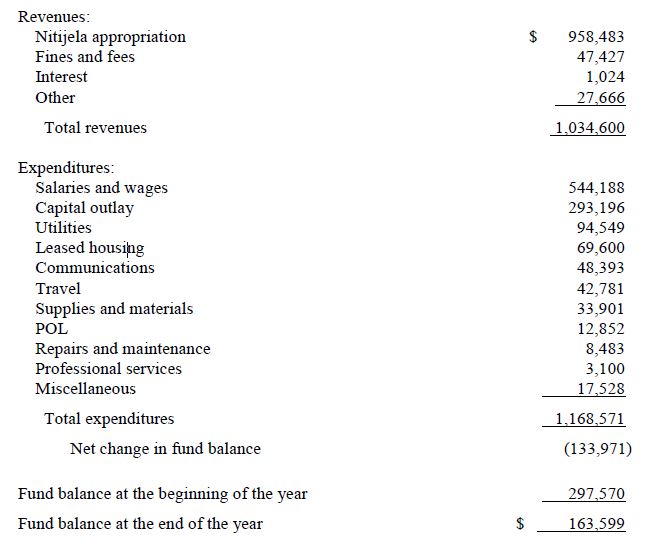
1 Other cases include the following: appeal
of government agency decisions, appointment of personal representatives,
corporate, declaratory relief, mandamus, maritime, torts, wrongful death, and
wrongful terminations.
PacLII:
Copyright
Policy | Disclaimers
| Privacy
Policy | Feedback|
Report
an error
URL: http://www.paclii.org/mh/court-annual-reports/2013.html













